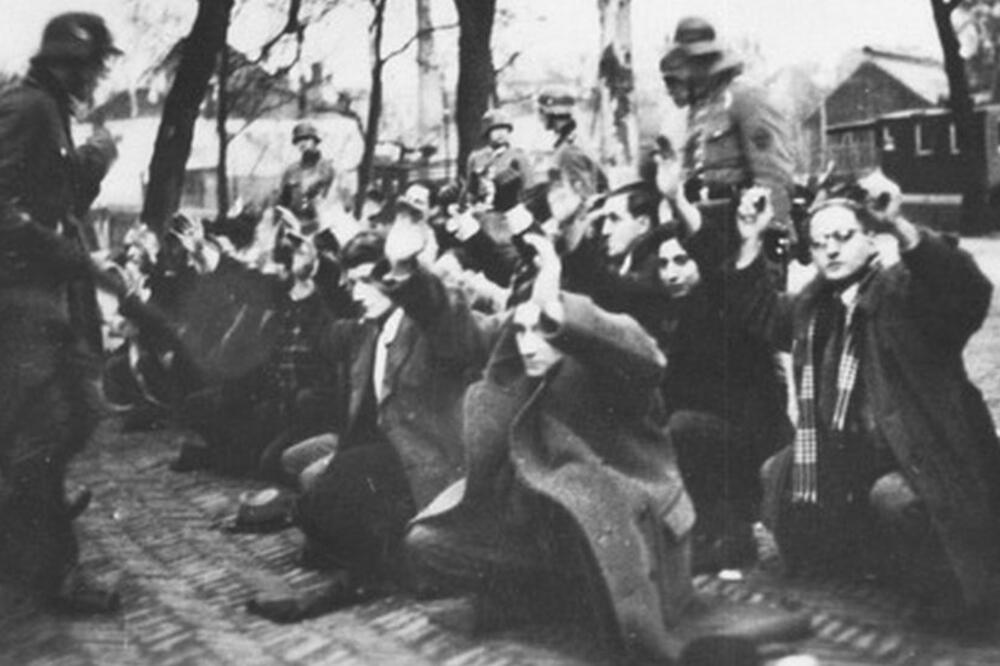More than 100 Dutch people were sent to their deaths in a secret Nazi gas chamber in 1941, a year before the Nazis would begin mass deportations of Jews and executions in this way.
The men were arrested in Amsterdam in February 1941, in the first Nazi raids on Jews in Western Europe, and taken to Mauthausen - a concentration camp in Austria.
Historian Vali de Lange says 108 people were killed in nearby Hartheim Castle.
The causes of death are made up, she explains.
Germany invaded the Netherlands in May 1940 and over the next five years more than three-quarters of the Jewish population were killed, with deportations to the Auschwitz death camp beginning in July 1942.
Mass arrests of Jews - raids - began on February 22 and 23, 1941 in retaliation for the murder of a Dutch collaborator of the occupiers.
The images of the first raid are known, but not what happened to the hundreds of arrested merchants, vendors, tailors and other residents of Amsterdam.

In the new book, De Lange explains in detail who these men were and what happened to them after they were taken to the Shorl prison camp in the north of the Netherlands.
From that camp, 388 people were sent to the Nazi concentration camp Buchenwald in Germany.
"It has always been thought that the first deportation train left in July 1942, (but) these people arrested in the raid were taken much earlier, already on February 27, 1941," the historian told the BBC.
Killing Center in Hartheim
Dozens of people died within a few weeks in the Buchenwald quarries, while the 340 remaining were sent south on May 22, 1941 to the Mauthausen concentration camp, 35 kilometers away from Hartheim Castle.
In 1940, this castle was turned into a killing center where 30.000 people with disabilities and special needs were executed, until public protests stopped this campaign.
Since 1941, it has been used as a place to kill 12.000 prisoners of the "Action 14f13" program.
It was the name of the Nazi program for the execution of concentration camp inmates who were no longer fit to work.
Spanish and Polish inmates were also killed here.
De Lange says there were two ways the Nazis used gas.
"During the bus ride, halfway to the castle and in Hartheim itself, in a place where no one could see what was going on."
Laboratory for Nazis
What was not known was that many Dutch prisoners were killed in the Hartheim gas chamber.
Families were given false causes of death and assumed to have died from lead poisoning in the mines.
De Lange says they were sent to Hartheim and killed between August 11 and 14, while weeks later they published false causes of death.
For 108 prisoners there is evidence that they were killed and cremated in Hartheim, adds the historian, but such a fate probably befell dozens of others.
She discovered in German archives that from September 1 to 6, 1941, up to 30 prisoners were listed alphabetically as having died every day.
At that time, every death had to be registered, so the historian is convinced that they were killed upon arrival, weeks earlier.
"It was a kind of laboratory (for the Nazis) where they wanted to improve their knowledge of everything that we see in the example of Auštica, only on a much larger scale."
With the genocidal "Final Solution," Hitler and other Nazi leaders emerged in January 1942.
As part of her research, historian De Lang identified many people who were photographed in Nazi detention centers in Amsterdam.
John Spell, the great-grandson of one of the arrested - Aaron Smer, says that he only had a name during all these years, while now he has a face.
"Something like that leaves you speechless," he told the Dutch public broadcaster NOS.
Follow us on Facebook i Twitter. If you have a topic proposal for us, contact us at bbcnasrpskom@bbc.co.uk
Bonus video:




